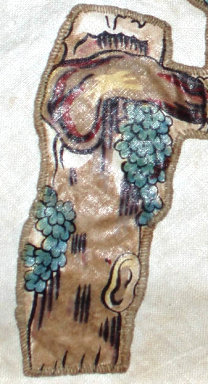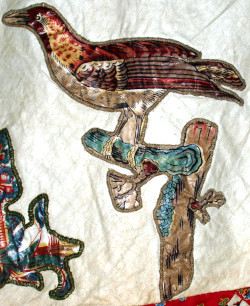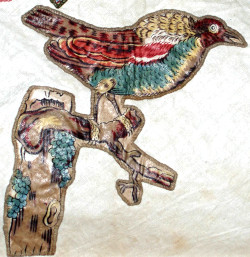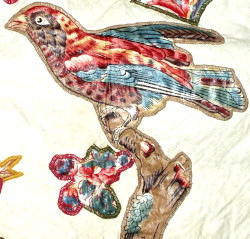Floral Motifs on Early Chintz
Flavoparmelia caperata (?) - Common Greenshield Lichen (?)

%20lichen_sm.jpg)
Flavoparmelia caperata (Common Greenshield Lichen) growing on a tree in a modern yard.
Foliose Lichen motif - probably Flavoparmelia caperata (Common Greenshield Lichen) on the Private Collection, Irish Chintz Applique coverlet, c. 1840



Foliose Lichen motifs (probably Flavoparmelia caperata (Common Greenshield Lichen)) including tree stumps and birds from the same Private Collection, Irish Chintz Applique coverlet, c. 1840
Common Names: Common Greenshield Lichen, Caper Border-moss
Description: This motif is probably Flavoparmelia caperata (Common Greenshield Lichen) based on the facts that it is foliose, apple green (to the best of the ability with dyes of the era), and growing on a tree trunk, as well as the fact that it would almost certainly have to be very common for a fabric designer in the 1800s to want use it to make the tree trunk look as realistic as possible. Flavoparmelia caperata (Common Greenshield Lichen) is a foliose lichen in the Lichen Family (Parmeliaceae) of the Fungi Kingdom, and thus technically not a floral motif. Lichens are currently recognized as being a composite "organism" composed of a fungus, an alga, and a yeast living in a symbiotic relationship. The British Lichen Society Twenty Common Lichens web page* lists Flavoparmelia caperata (Common Greenshield Lichen) as a native of Great Britain as does Samuel Frederick Gray's 1821 book A Natural Arrangement of British Plants (then called Parmelia caperata).
Quilts with Flavoparmelia caperata (Common Greenshield Lichen):
Chintz with Flavoparmelia caperata (Common Greenshield Lichen):
* "Twenty Common Lichens," British Lichen Society, http://http://www.britishlichensociety.org.uk/sites/www.britishlichensociety.org.uk/files/document-downloads/Next%20Steps%20Field%20Guide%20Part%202.PDF; accessed August 6, 2018.
© Updated 8/12/2018 Author: Terry Tickhill Terrell
Description: This motif is probably Flavoparmelia caperata (Common Greenshield Lichen) based on the facts that it is foliose, apple green (to the best of the ability with dyes of the era), and growing on a tree trunk, as well as the fact that it would almost certainly have to be very common for a fabric designer in the 1800s to want use it to make the tree trunk look as realistic as possible. Flavoparmelia caperata (Common Greenshield Lichen) is a foliose lichen in the Lichen Family (Parmeliaceae) of the Fungi Kingdom, and thus technically not a floral motif. Lichens are currently recognized as being a composite "organism" composed of a fungus, an alga, and a yeast living in a symbiotic relationship. The British Lichen Society Twenty Common Lichens web page* lists Flavoparmelia caperata (Common Greenshield Lichen) as a native of Great Britain as does Samuel Frederick Gray's 1821 book A Natural Arrangement of British Plants (then called Parmelia caperata).
Quilts with Flavoparmelia caperata (Common Greenshield Lichen):
- Private Collection, Irish Chintz Applique coverlet, c. 1840
- Shelburne Museum, Chintz Applique Counterpane, Chintz Quilts: Unfading Glory, p. 32, late 18th century
Chintz with Flavoparmelia caperata (Common Greenshield Lichen):
- None currently known
* "Twenty Common Lichens," British Lichen Society, http://http://www.britishlichensociety.org.uk/sites/www.britishlichensociety.org.uk/files/document-downloads/Next%20Steps%20Field%20Guide%20Part%202.PDF; accessed August 6, 2018.
© Updated 8/12/2018 Author: Terry Tickhill Terrell